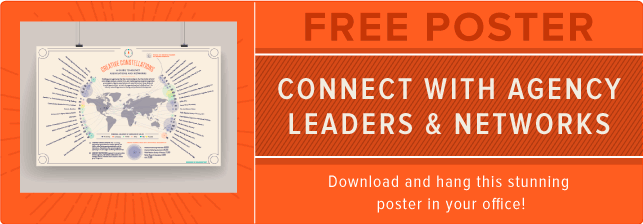

An agency pitch gets the blood pumping. It’s a winner-take-all, final competition, and agencies will go to any extreme to win. But what wins is usually more about being smart than being extreme.
If you want to win more pitches, check out these six tips for outshining your competitors and making a memorable impression on your prospective client:
1) Worry more about how you act and less about what you say.
Prospects know agencies will say whatever they think will win the business, so they don’t put too much faith in those words. Prospects will learn more about you by how you act throughout the entire pitch process than the words you actually say during the pitch. How quickly you respond to requests, if you are timely, how your agency team treats one another, and even how you answer the phone communicates who your agency is more persuasively than anything else.
We tried to give the client an idea of how we interact with each other in a recent pitch. Typically, people introduce themselves, but we decided to introduce one another, allowing each team member to send praise toward his colleague. The person who introduced our CEO had planned to describe the CEO’s career as meteoric. In his nervousness, the poor guy said the CEO’s career was mediocre. This could have been a problem, but our CEO's reaction was to laugh. This put the speaker at ease, lightened up the mood of the meeting, and made the prospect feel better about doing business with us. The CEO’s reaction told the potential client more about what it would be like to work with us than anything we might have said.
2) Show the client’s management team that you know how to listen.
Try to secure an opportunity to talk to the key people at the prospect's firm early on so you can better understand the company and the team's hopes for the future. When you gain access, ask the managers some simple questions to get them talking. The people you will be talking to are smart, opinionated people who will be thrilled to see their ideas addressed in the pitch.
Some useful questions are:
- If everything works out well, where will your company be in five years?
- If all goes well, what will your customers think of your company?
- If all goes well, what will your employees think of your company?
- In your opinion, what are the biggest obstacles that stand between your company and that bright future?
- What are your biggest worries?
If, for example, management is concerned about a particular competitor, you can make great use of that fact in your presentation, highlighting the impact your proposed solution will have to destroy the competition.
3) Ignore what prospects say they want in an agency.
Prospects don’t know what they really want in an agency. They only know what they want for the future of their company.
Once a prospect told us, as we were preparing for a pitch, that he was really looking for a smaller agency. Apparently he felt he would rather be a big fish in a small pond. So, during the pitch, we did our best to convince him that we were small even though we were the second biggest agency in town. It was a mistake.
What the prospect really wanted was success for his company. We should have simply talked about the goals he wanted to achieve and shown them how we, with our size, were the best agency to help. He came to realize he wanted a bigger agency, and he picked one -- it just wasn't us.
4) Cast for compatibility more than quality.
It’s hard for your prospects to judge the relative quality of professional services, but it’s easy for your prospects to pick the people they would like to work with. Who you cast for the pitch team and the relationships they develop with the client side could swing the vote.
We faced this when pursuing a retail chain brand. We quickly realized that the client wasn’t happy, and while the original agency team was highly skilled, they couldn't seem to form a connection with the marketers. We decided to recast the agency team completely. At first, we worried our change of personnel would show lack of commitment or indecision. Instead, the recasting showed how responsive the agency was to client desires. This switch helped bring the business home.
5) Give your punch line power with a strong setup.
The setup is why the prospect’s target audience is not doing something that he wants them to do. The prospect may want consumers to call a phone number, visit a website, order larger quantities, go to the brand's store instead of another store ... the list goes on. The setup is a story that explains why the audience isn’t taking a desired action and what can be done to change this. The punch line is how you are going to solve the problem.
With the right setup, your punch line can seem brilliant. With a weak setup, the same punch line can fall flat. Pitches, like jokes, more often fail because of a weak setup than a weak punch line.
6) Sell the sizzle, not a detailed plan.
A concrete and specific suggestion invites criticism. What you want to do instead is raise hopes and expectations. Lead the prospect to see the promise of a brilliant solution just around the corner and the opportunity to help deliver it. Don’t give it over prematurely.
Explain that the final solution requires the client’s participation, and because of this, it will likely be different. Prospects want an agency they can work with. They don’t want to be presented with a comprehensive plan and final decisions by an agency that thinks it knows it all.





![Do You Know Why You Lost That Pitch? [+Email Template]](https://blog.hubspot.com/hubfs/Agency_Post/Blog_Images/pitch-questions.png)


![What We Leave Behind [Pitch Pain]](https://blog.hubspot.com/hs-fs/hub/53/file-2053310476-jpg/blog-files/burger-king-pitch-300x300.jpg)

